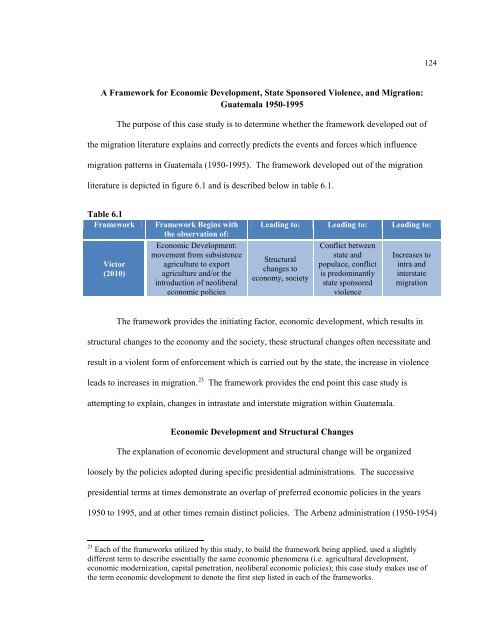Complete Thesis_double spaced abstract.pdf
Complete Thesis_double spaced abstract.pdf
Complete Thesis_double spaced abstract.pdf
You also want an ePaper? Increase the reach of your titles
YUMPU automatically turns print PDFs into web optimized ePapers that Google loves.
A Framework for Economic Development, State Sponsored Violence, and Migration:<br />
Guatemala 1950-1995<br />
The purpose of this case study is to determine whether the framework developed out of<br />
the migration literature explains and correctly predicts the events and forces which influence<br />
migration patterns in Guatemala (1950-1995). The framework developed out of the migration<br />
literature is depicted in figure 6.1 and is described below in table 6.1.<br />
Table 6.1<br />
Framework Framework Begins with<br />
the observation of:<br />
Victor<br />
(2010)<br />
Economic Development:<br />
movement from subsistence<br />
agriculture to export<br />
agriculture and/or the<br />
introduction of neoliberal<br />
economic policies<br />
Leading to: Leading to: Leading to:<br />
Structural<br />
changes to<br />
economy, society<br />
Conflict between<br />
state and<br />
populace, conflict<br />
is predominantly<br />
state sponsored<br />
violence<br />
Increases to<br />
intra and<br />
interstate<br />
migration<br />
The framework provides the initiating factor, economic development, which results in<br />
structural changes to the economy and the society, these structural changes often necessitate and<br />
result in a violent form of enforcement which is carried out by the state, the increase in violence<br />
leads to increases in migration. 23<br />
The framework provides the end point this case study is<br />
attempting to explain, changes in intrastate and interstate migration within Guatemala.<br />
Economic Development and Structural Changes<br />
The explanation of economic development and structural change will be organized<br />
loosely by the policies adopted during specific presidential administrations. The successive<br />
presidential terms at times demonstrate an overlap of preferred economic policies in the years<br />
1950 to 1995, and at other times remain distinct policies. The Arbenz administration (1950-1954)<br />
23 Each of the frameworks utilized by this study, to build the framework being applied, used a slightly<br />
different term to describe essentially the same economic phenomena (i.e. agricultural development,<br />
economic modernization, capital penetration, neoliberal economic policies); this case study makes use of<br />
the term economic development to denote the first step listed in each of the frameworks.<br />
124














![Completed Thesis to Grad Studies[Final3].pdf](https://img.yumpu.com/17538645/1/190x245/completed-thesis-to-grad-studiesfinal3pdf.jpg?quality=85)
